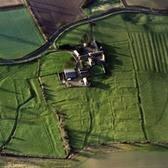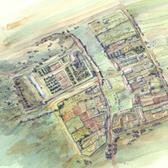Region: North East
Unitary Authority: Darlington
Owner Type: Private
Funding Body: English Heritage, Natural England
Year of Intervention: 2007 - 2008
Summary: A tenant farmer is seeking to make the most of the historic and natural assets on his land: the deserted medieval village of Ulnaby and the ancient pasture in which the village’s earthwork remains are preserved. With support, advice and grants from English Heritage and Natural England, primarily through a Higher Level Stewardship scheme, the farmer has put in place a presentation and interpretation scheme and encouraged access to the land, and turned his existing tea room and farm shop into a small but profitable visitor centre.
Description: Ulnaby, near Darlington, was inhabited from before Domesday until the mid-18th century, its gradual decline apparently brought about by the introduction of sheep to the former arable land. The settlement seems to have reached its hey-day in the early 14th century, when it was re-organised as a planned village, with two long rows of peasant cottages facing onto a central green. A walled manorial enclosure, including a fishpond, a dovecote and perhaps gardens and orchards. was laid out over what may previously have been peasant plots. These remains now survive as recognisable humps and bumps under pasture. This grassland has been maintained by sheep grazing since the late Middle Ages, and now represents an important ecological habitat in a largely arable landscape: hares and owls thrive. The probable site of the medieval manor is now lost beneath modern farm buildings. In 1609, a fine new hall was built on a different site towards one end of the village site; this building is now inhabited by the farmer. The whole complex, though only partially understood, is protected as a Scehduled Ancient Monument.
Issue: The tenant farmer was searching for means to diversify his economic basis. Previously, he has introduced rare livestock breeds, as well as a number of exotic species such as llamas, used the spring that once served the medieval village to create a duckpond, and constructed a children’s play area. All these were intended to attract visitors to a tearoom and farm shop built in a 19th-century stable wing. The remains of the deserted medieval village obviously held potential as a visitor attraction, but the question was how to release that potential. Historic sites where only low earthworks now survive can be disappointing for non-expert visitors and therefore demand special measures to make them comprehensible and interesting. The same is true of the native fauna and flora on the land: how can their potential as a visitor attraction be harnessed best?
Strategy: An analytical survey of the humps and bumps was carried out by English Heritage’s own Research Department as support in kind. This provided the foundation of understanding on which the subsequent management decisions were made. Natural England was able to offer significant financial support to facilitate increased access to the land and interpretation of its historic and ecological assets under the terms of a Higher Level Stewardship scheme. English Heritage’s Advice and Grants team for the North-East region supplemented this with grants targeted specifically at improving the presentation and interpretation of the historic remains. Grants were given to commission a reconstruction painting of what the village may have looked like in the early 14th century, which was used on an interpretation board and in a self-guided walk leaflet. Advice on how vehicle access could be achieved without damaging the historic earthworks was backed up with grants towards the cost of constructing styles, gates and bridges. As part of the dissemination of the new research, English Heritage’s experts led a series of guided walks, which were advertised locally. These helped to create a bond between local people and a historic site ‘in their own back yard’, while also offering the farmer a template on which to base subsequent events. The farmer continues to develop new ideas for presenting Ulnaby’s historic and ecological assets, with guidance from English Heritage and Natural England.
Outcome: Ulnaby offers a model for how a farmer with vision and energy can work with the relevant government agencies to harness the potential of heritage and ecology and turn them into real assets, bringing benefits to all: to the farmer and the local economy, to local people and visitors from further afield, and to the sustainable management of the heritage and ecology themselves.
Keywords: EDUCATION AND OUTREACH; DISPLAY AND INTERPRETATION; GRANTS; SOCIAL INCLUSION AND ACCESS; MANAGEMENT PLANS; SUSTAINABILITY
© Enlgish Heritage


